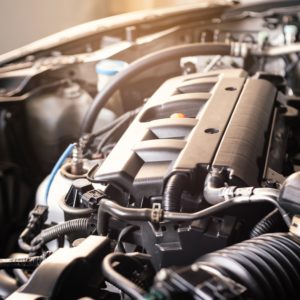When the ECM/PCM detects a problem with the signal sent by the Manifold Absolute Pressure (MAP) sensor the P0108 code will be stored by the ECM/PCM. Learn more about this code in the following guide.
What Does the P0108 Code Mean?
Diagnostic trouble code (DTC) P0108 code stands for “Manifold Absolute Pressure/Barometric Pressure High.” It is triggered by the ECM when it receives a signal from the MAP/BARO sensor circuit that is above the normal range.
Typically, the MAP/BARO sensor is supplied with regulated volts by the ECM on a 5-volt reference circuit. Older Fords use a three-wire sensor that uses 5 volts, but the output signal isn’t a voltage, it’s a frequency. At sea level with the engine off and the key on, a Ford MAP sensor typically reads about 158 hertz, but when the engine starts, the frequency drops to about 110 hertz. On this type of MAP sensor (as well as on the analog voltage type sensors used by GM, Dodge, and some other makes), an in-range failure of the MAP sensor can cause issues without a MAP sensor code being set.

If you’re planning a DIY approach to fix P0108, you may read our technical discussion about intake manifold pressure for more information.
Otherwise, continue reading for the possible causes of P0108.
What are the Possible Causes of the P0108 Code?
- Defective MAP/BARO sensor
- Faulty, corroded, or loose MAP/BARO sensor circuit wiring or connections
- Restricted vacuum source for the MAP/BARO sensor
- Defective, damaged, or clogged catalytic converter(s)
- In rare cases, a malfunctioning ECM
What are the Common Symptoms of the P0108 Code?
Illuminated Check Engine Light
There are plenty of error codes that may switch on the check engine light. To confirm that it has been triggered by a MAP/BARO sensor circuit malfunction, you’ll need to connect an OBD-II scan tool to your vehicle’s OBD port.
Reduced fuel economy

An issue with the MAP sensor can throw off your car’s air/fuel ratio, leading to increased fuel consumption.
Poor engine performance
A malfunction in the MAP/BARO sensor circuit may also affect the drivability of your vehicle. Your car may become hard to start, hesitate during acceleration, stall unpredictably, or experience rough idling.
How to Diagnose the P0108 Code
Now that we know what causes a P0108 code as well as its symptoms, the next step is identifying which issue has triggered this code to be logged on your vehicle. Don’t hesitate to take your vehicle to a professional if you’re unsure of performing the diagnosis.
If you’re an experienced DIY-er looking for advice on testing and fixing this trouble code yourself, here are some videos that may give you a better idea of what the troubleshooting process might involve:
How to Fix the P0108 Code
The P0108 code is a generic DTC, which means it’s supported by various makes and models. While most vehicles will experience similar symptoms, the steps for diagnosis and repair may be different between vehicle models.
If you’re unsure about having enough technical knowledge to fix the code yourself, it’s best to bring your vehicle to the nearest auto repair shop for expert advice. If you decide on doing it on your own, repair manuals (like those from Chilton) and an ALLDATA vehicle subscription are great resources for factory repair information.
Intake Manifold Pressure
There are a couple of basic types of fuel injection systems (pre-GDI). One of these is a “speed density” system, where there is a pressure sensor reading Intake manifold pressure (a.k.a., “manifold absolute pressure”) to determine engine load. The other type (not discussed in this article) is the Mass Airflow (MAF) type system. Some MAF systems also have a MAP sensor.
We talk a lot about intake manifold vacuum, but MAP is basically a measurement of the differential between ambient atmospheric pressure and the pressure in the manifold.
Ambient atmospheric pressure at sea level measured in PSI is 14.7. In the metric system, that’s 1 BAR.
That’s what we call atmospheric pressure, and it decreases with altitude. But the ECM/PCM measures barometric pressure and intake pressure in inches of mercury (that’s how it’s measured, using a graduated tube and a set amount of mercury). Each PSI of pressure equals approximately 2 inches of mercury (Mercury is “Hg” on the periodic table).

If, for example, barometric pressure is 30 inches of mercury and engine vacuum is 20 inches of mercury idling, then manifold absolute pressure is, at that point, 10 inches – which is the difference between 30 inches and the 20 inches of manifold vacuum. Manifold vacuum is created by the pistons creating low pressure as they travel down on their intake strokes with the throttle plate closed and airflow at a minimum.
As the throttle plate opens and the engine is loaded, manifold pressure increases and vacuum decreases. Thus, manifold pressure is an accurate indicator of engine load. That’s why some older automatic transmissions had a vacuum line from the manifold connected to the transmission modulator valve to modify transmission shifts under load.
So, manifold absolute pressure is used by the ECM/PCM to calculate engine load, which is the primary input the ECM/PCM uses to determine fuel injector pulse width while the engine is doing its work. The higher the measured MAP, the wider the fuel pulse with each injector event.
When the key is switched on initially, the ECM/PCM records closed throttle voltage, intake air and engine coolant temperature, and barometric pressure using the MAP sensor. These factors determine how much fuel is delivered when the engine is starting and after it fires up.
Where To Buy Parts for the P0108 Code
If your scan tool’s showing a P0108 trouble code, chances are that you’ll need a new MAP/BARO sensor or a catalytic converter. Good thing you can find a replacement easily here at CarParts.com!
Our price match guarantee ensures you’ll get the best deals if you purchase parts on our website. This even applies post-purchase if you find a competitor offering the same products at a lower price. Our other guarantees include lifetime replacement and a guaranteed fit.
What are you waiting for? You don’t even need to leave your house to enjoy these benefits. Browse our catalog today for everything you need and enjoy our great deals!
Products Mentioned in this Guide
Any information provided on this Website is for informational purposes only and is not intended to replace consultation with a professional mechanic. The accuracy and timeliness of the information may change from the time of publication.


 Catalytic Converter
Catalytic Converter
 Barometric Pressure Sensor
Barometric Pressure Sensor
 MAP Sensor
MAP Sensor


















